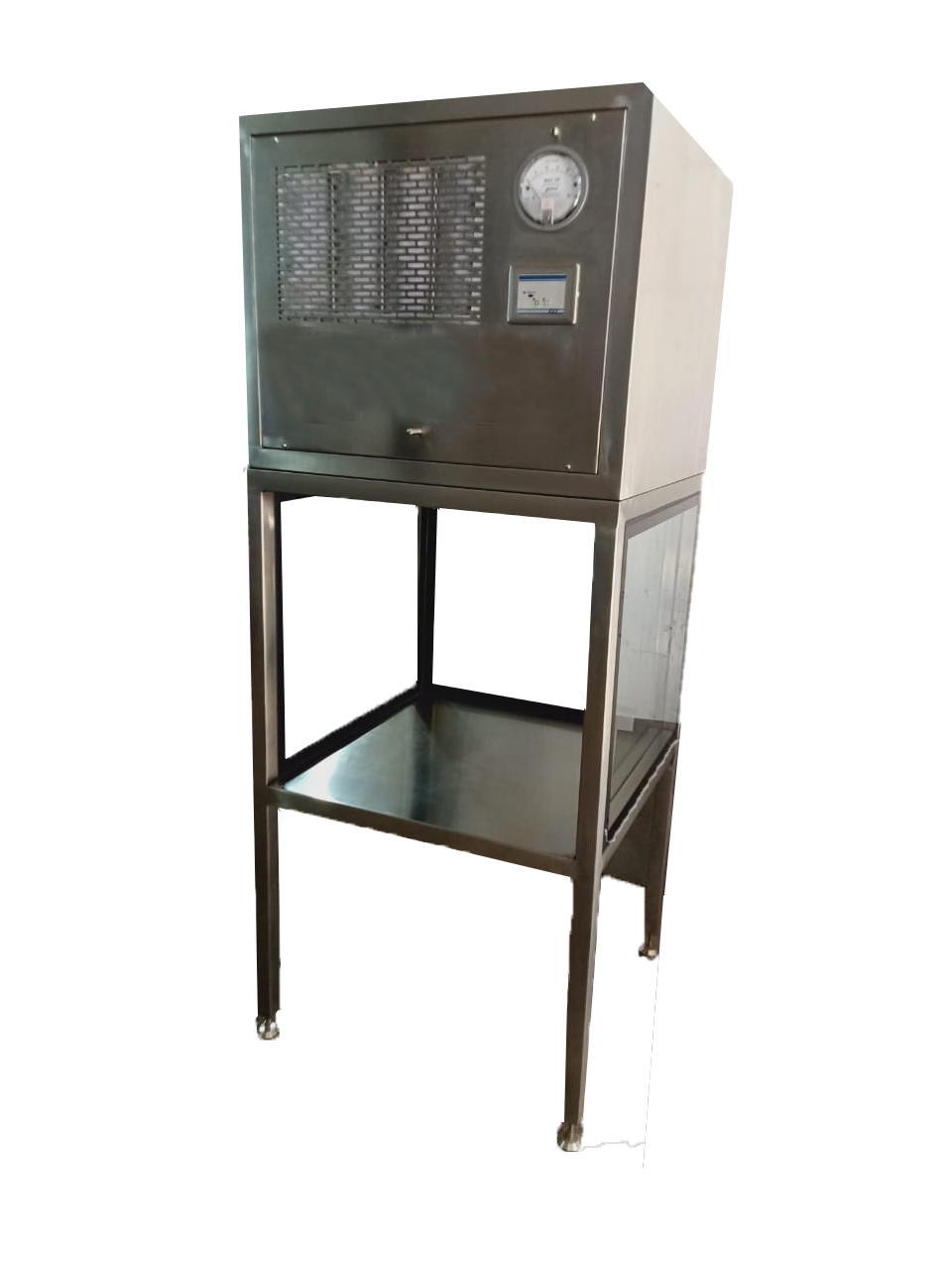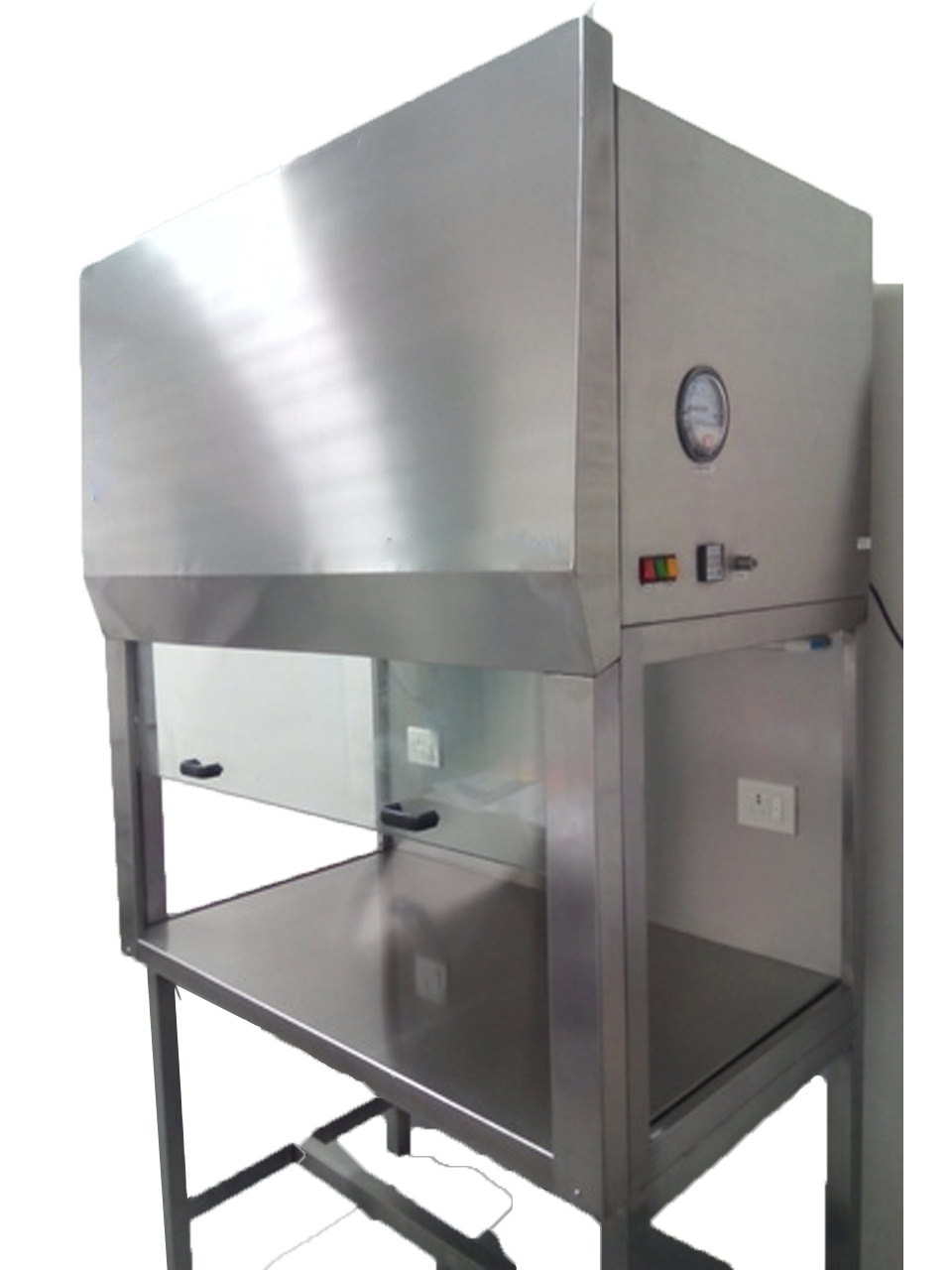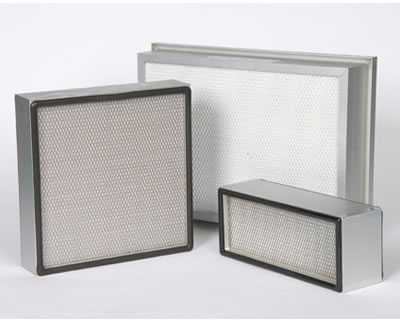
Stand Mounted Laminar Air Flow unit is designed specifically for product protection. The Cabinet is a clean bench which provides ultra clean sterile HEPA filtered class 100 air in an isolated area for operations requiring a particulate-free environment where the highly sensitive process activities are carried-out. The VLAF unit draws air in through the top of the unit through prefilter, through a plenum and vertically down over the work surface and past the lap of the operator. It has the advantage of not pushing air into the operator as in horizontal laminar flow cabinet.
We offer Vertical Laminar Air Flow (Stand Mounted Version). These are unidirectional airflow systems that have a confined area moving in a uniform velocity along parallel flow lines. The system has a continuous flow of HEPA / ULPA filtered Air downwards across the work area. Uniform stream of air filtered air moves forward over the work surface from the rear of the work area and the airflow across the work area is directed at the user and exhaust.
| EQUIPMENT TYPE | EQUIPMENT DIMENSIONS IN FEETS | MM |
|---|---|---|
| VERTICAL LAF (STAND MOUNTING LAF) | 2X2X2 | 610X610X610 |
| 3X2X2 | 915X610X610 | |
| 3X3X2 | 915X915X610 | |
| 4X2X2 | 1220X610X610 | |
| 5X2X2 | 1525X610X610 | |
| 6X2X2 | 1830X915X610 | |
| WITH STAGE | ||
| 2X2X6 | 610X610X1830 | |
| 3X2X6 | 915X610X1830 | |
| 3X3X6 | 915X915X1830 | |
| 4X2X6 | 1220X610X1830 | |
| 5X2X6 | 1525X610X1830 | |
| 6X2X6 | 1830X915X1830 | |
Additional Information:
- Pay Mode Terms: L/C (Letter of Credit),T/T (Bank Transfer)
- Port of Dispatch: Chennai
- Production Capacity: 100 Units per Month
- Delivery Time: 4 Weeks
- Packaging Details: Wooden Pallet
Introduction to laminar flow clean bench
A laminar flow cabinet is defined as enclosed workbench which is used to create a contamination free work environment through installed HEPA filters that capture all the particles entering the cabinet. A laminar flow hood is used for work with substances which are not hazardous for the personnel health.

Desktop laminar flow chambers, also known as laminar flow clean benches, are similar to biosafety cabinets in the sense that they are equipments used to clean up the ambient air completely through a filtration process. Generally, laminar air flow is designed to prevent the contamination of semiconductor wafers, some sensitive materials, and even biological samples.
A laminar flow unit has an industry-wide usage and can be applied in quite a lot of industries such as medical, research, pharmacy, educational, аnd also in electronics, optics, micromechanics, plastic industries, etc. since they carry out processes that require a clean and sterile environment. A laminar hood is used for work with substances which are not hazardous for the personnel health, and it does not provide personal protection. The best usage of a clean bench is for working on certainly specialized experiments in the labs that require a clean environment to design products that are nontoxic. It creates clean air for an individual environment, which is necessary for smaller items - for example, sensitive electronic devices. Hence, it can be tailor-made under the specific requirements of the laboratory.
How does a laminar air flow unit work?
A laminar flow unit creates dust free abacterial air environment.
Air from the room passes through the HEPA (High Efficiency Particulate Absorbing) filters and is fed into the working chamber by a unidirectional vertical descending flow. From the working area the air is moved back to the environment in the following way: partly – through the perforation in the bottom rear area of the cabinet, but most air – through the space between the working surface of the table and the protecting glass.
Laminar flow hood involve a unidirectional exhaustion of air to the workplace and personnel whereby filtered air is discharged with a regular and fixed velocity.
Some of the basic components of a laminar flow chamber include UV light, glass shield, an air intake fan, a protection plate, windows, etc. Each of the components of a clean bench plays an important role in creating and maintaining sterile conditions. The fan pulls the air through the filter pad where the dust is pinned down; then, the HEPA filter pulls out all airborne contamination to maintain sterile conditions.
Types of laminar flow hoods
The direction in which the air moves is based on the specific laminar cabinet that is being used. The type of cell culture hood needed depends very much on the requirements of the laboratory, the kind of airflow needed, working principle, and the type of operation. Two main types of laminar flow hoods differ according to the functions they can perform: horizontal airflow hood and vertical airflow hood.
Horizontal airflow hood
The ambient air comes from the behind the laminar air flow bench, then it is projected through a blower towards the HEPA filter, and the filtered air is exhausted in a horizontal direction to the workplace environment.
Airflow that is parallel to the workplace cleanses the environment with a constant velocity. Horizontal laminar chamber needs a larger operational space and more depth to provide a germ-free environment and hence is more difficult to handle.
Vertical airflow hood
Our company specializes in the production of vertical airflow laminar cabinets, it is the most demanded product because of the advanced technology combined to remove all the impurities from the environment.
- The illumination block is taken out of the working chamber and does not initiate air flow turbulence.
- Coloring of the cabinet is made with the powder enamel resistant to disinfectant solutions.
- The control unit with LCD indicates the switching of the systems, their possible malfunctions, the operation mode chosen and devices technological timer.
- HEPA filter is held by springs providing filter leak tightness for the whole lifetime.
- The electronic shield panel provides easy operation and disinfection.
- The UV light module is used for disinfection of the working chamber and its surfaces.
- The working principle of a vertical laminar unit is quite different from a horizontal airflow hood because it consists of a fan which is placed on the ceiling of the cabinet and the contaminated air is taken in through that fan and directed from the bench top downwards in a vertical direction with a positive pressure.
Usually, vertical airflow benches have a width ranging 0,9-2,4 m. With all these excellent machines, technologies and an economical system, vertical airflow laminar hood is state-of-the-art. It provides greater protection from harm and uses less operational and floor space.
Horizontal versus vertical chamber
Since we are the largest manufacturer and suppliers of laminar airflow chambers, it is our responsibility to guide you to the best type of product to use by comparing both of them. A vertical airflow clean bench does not require as much depth and floor space as a horizontal airflow hood which makes it more manageable and decreases the chances of airflow obstruction or collection of contaminated air downstream.
Moreover, the safety level of the vertical laminar hood is comparatively greater because it does not blow the air directly towards the person carrying out the experiments. The front sash installed acts as a barrier against the fumes by preventing a direct attack on the person’s face. Also, in a horizontal airflow hood filter replacement needs moving of hoods and cabinets but in the vertical airflow chamber, filter replacement is much more rapid and easier, since the filter is placed at the top of the vertical module.
Lastly, vertical airflow laminar units have more unidirectional and less turbulent effects from the air streams projected through them on the products being processed. After knowing all these extra benefits, you have quite a lot of compelling reasons to choose a vertical airflow laminar unit.
Laminar Flows
Laminar air flows can maintain a working area devoid of contaminants. Many medical and research laboratories require sterile working environments in order to carry out specialised work. Laminar Flow Cabinets can provide the solution.
Why Laminar Flow Cabinets?
Laminar Flow Cabinets create particle-free working environments by projecting air through a filtration system and exhausting it across a work surface in a laminar or uni-directional air stream. They provide an excellent clean air environment for a number of laboratory requirements.
Uses
Laminar Flow Cabinets are suitable for a variety of applications and especially where an individual clean air environment is required for smaller items, e.g. particle sensitive electronic devices.
In the laboratory, Laminar Flow Cabinets are commonly used for specialised work.
Laminar Flow Cabinets can be tailor made to the specific requirements of the laboratory and are also ideal for general lab work, especially in the medical, pharmaceutical, electronic and industrial sectors.

How They Are Made
Laminar Flow Cabinets, or laminar air flow cabinets as they are also known, are normally made of stainless steel with no gaps or joints thereby preventing the build-up of bacteria from collecting anywhere in the working zone.
Laminar Flow Cabinets are also known as clean benches because the air for the working environment is thoroughly cleaned by the precision filtration process.
How They Work
The process of laminar air flow can be described as airflow where an entire body of air flows with steady, uniform velocity.
Laminar Flow Cabinets work by the use of in-flow laminar air drawn through one or more HEPA filters, designed to create a particle-free working environment and provide product protection. Air is taken through a filtration system and then exhausted across the work surface as part of the laminar flows process.
Commonly, the filtration system comprises of a pre-filter and a HEPA filter. The Laminar Flow Cabinet is enclosed on the sides and constant positive air pressure is maintained to prevent the intrusion of contaminated room air.

Types of Laminar Flow Cabinets
Laminar Flow Cabinets can be produced as both horizontal and vertical cabinets. There are many different types of cabinets with a variety of airflow patterns for different purposes.
- Vertical Laminar Flow Cabinets
- Horizontal Laminar Flow Cabinets
- Laminar Flow Cabinets and Hoods
- Laminar Flow Benches and Booths
All ensure a work space devoid of contaminants and may be tailored to the lab requirements.
Horizontal Laminar Flow Cabinets
Horizontal Laminar Flow Cabinets receive their name due to the direction of air flow which comes from above but then changes direction and is processed across the work in a horizontal direction. The constant flow of filtered air provides material and product protection.
Vertical Laminar Flow Cabinets
Vertical Laminar Flow Cabinets function equally well as horizontal Laminar Flow Cabinets with the laminar air directed vertically downwards onto the working area. The air can leave the working area via holes in the base. Vertical flow cabinets can provide greater operator protection.

